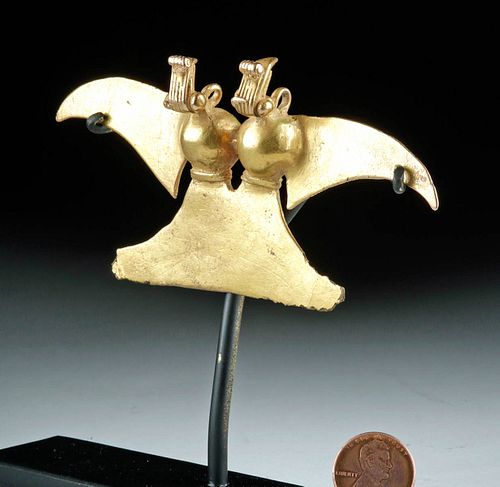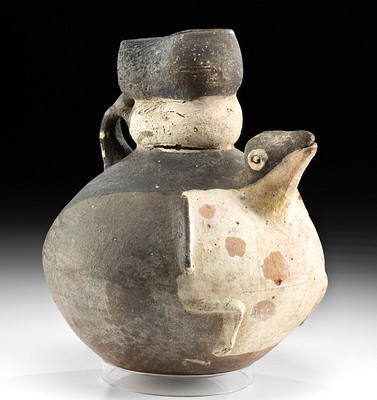Panamanian 20K+ Gold Pendant, Double-Headed Avian
Lot 40b
About Seller
Artemis Fine Arts
686 S Taylor Ave, Ste 106
Louisville, CO 80027
United States
Selling antiquities, ancient and ethnographic art online since 1993, Artemis Gallery specializes in Classical Antiquities (Egyptian, Greek, Roman, Near Eastern), Asian, Pre-Columbian, African / Tribal / Oceanographic art. Our extensive inventory includes pottery, stone, metal, wood, glass and textil...Read more
Categories
Estimate:
$15,000 - $20,000
Absentee vs Live bid
Two ways to bid:
- Leave a max absentee bid and the platform will bid on your behalf up to your maximum bid during the live auction.
- Bid live during the auction and your bids will be submitted real-time to the auctioneer.
Bid Increments
| Price | Bid Increment |
|---|---|
| $0 | $25 |
| $300 | $50 |
| $1,000 | $100 |
| $2,000 | $250 |
| $5,000 | $500 |
| $10,000 | $1,000 |
| $20,000 | $2,500 |
| $50,000 | $5,000 |
| $100,000 | $10,000 |
| $200,000 | $20,000 |
About Auction
By Artemis Fine Arts
Oct 28, 2021
Set Reminder
2021-10-28 12:00:00
2021-10-28 12:00:00
America/New_York
Bidsquare
Bidsquare : Fauna, Flora, Stone & Bones - Fall Edition
https://www.bidsquare.com/auctions/artemis-gallery/fauna-flora-stone-bones---fall-edition-7768
Join us for a very special early Fall auction featuring fabulous fossils, rocks, and minerals, plus art depicting flora and fauna from antiquity to present day. This is one sale you won't want to miss! Artemis Fine Arts info@artemisgallery.com
Join us for a very special early Fall auction featuring fabulous fossils, rocks, and minerals, plus art depicting flora and fauna from antiquity to present day. This is one sale you won't want to miss! Artemis Fine Arts info@artemisgallery.com
- Lot Description
Pre-Columbian, Central America, Panama, Veraguas culture / Grand Chiriqui Period V-VI, ca. 800 to 1500 CE. A huge gold (85% pure, equivalent to 20K+) pendant in the form of a double-headed bird. Its tail feathers and wings are broad and flat, spread out below and to either side of the raised bodies and heads of the twin birds. Each bird's head is ornate, with bulging eyes and a large crest along their long, wide beaks. With two loops on the undersides of the beaks to make it wearable. Size: 4.5" W x 2.25" H (11.4 cm x 5.7 cm); 4.35" H (11 cm) on included custom stand; gold is 82% pure, with 14% copper and 3% silver. Total weight: 42.8 grams
According to "The Art of Pre-Columbian Gold: the Jan Mitchell Collection" catalogue, "Isthmian bird-form pendants were first called 'eagles,' aguilas, when Christopher Columbus sailed along Caribbean Central America in the early 1500s. Columbus and his men saw the bird pendants being worn about the neck by the peoples of the coast, in the manner of 'an Agnus Dei or other relic' (Colon, 1959). They named the pendants aguilas, a name they have kept to this day. In the present century, the generalized avian form of the pendants has given rise to much discussion over which type of bird is represented (see Cooke & Bray, this catalogue). Some authorities believe that the pendants depict birds of prey, thereby endorsing the Spanish name. The prominence of beaks and claws, and the various items held in their beaks, support such a view. . . Veraguas eagles are sharp-edged and clean of outline, particularly when compared to those of Chiriqui style with their rounded contours. Wings and tail are worked more laterally . . . Veraguas eagles are also often more elaborated around the head and hold fewer things in their beaks." (Boston: Little Brown and Company, 1985, p. 112).
Columbus's expedition to the area - his last to the New World - included contact with the Veraguas, who, according to his records, embalmed their dead and bedecked them in gold finery. He traveled with a local guide to the furthest west port of their territory, where he encountered twenty canoes manned by people wearing nothing but gold plates and a gold eagle. Fascinatingly, what most struck Columbus and his men was that these gold ornaments were worn by nearly everyone amongst the Veraguas - the leader was dressed like everyone else! Indeed, what most impressed Ferdinand Columbus, the explorer's son who had accompanied him on the mission, was the number of wives that the leader had, apparently the true indication of wealth in that society.
Provenance: ex-Howard Rose Gallery, New York, New York, USA
All items legal to buy/sell under U.S. Statute covering cultural patrimony Code 2600, CHAPTER 14, and are guaranteed to be as described or your money back.
A Certificate of Authenticity will accompany all winning bids.
PLEASE NOTE: Due to recent increases of shipments being seized by Australian & German customs (even for items with pre-UNESCO provenance), we will no longer ship most antiquities and ancient Chinese art to Australia & Germany. For categories of items that are acceptable to ship to Australia or Germany, please contact us directly or work with your local customs brokerage firm.
Display stands not described as included/custom in the item description are for photography purposes only and will not be included with the item upon shipping.
#145137Small losses to edges of tail feathers. Light patina on surface. One of the birds' heads is slightly bent. Otherwise in beautiful condition.Condition
- Shipping Info
-
All shipping is handled in-house for your convenience. Your invoice from Artemis Gallery will include shipping calculation instructions. If in doubt, please inquire BEFORE bidding for estimated shipping costs for individual items.
-
- Buyer's Premium



 EUR
EUR CAD
CAD AUD
AUD GBP
GBP MXN
MXN HKD
HKD CNY
CNY MYR
MYR SEK
SEK SGD
SGD CHF
CHF THB
THB














